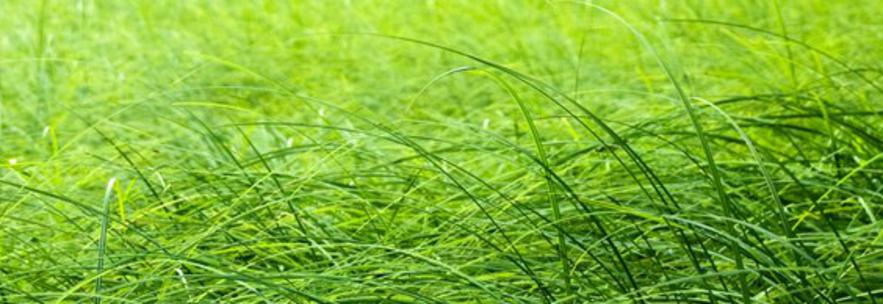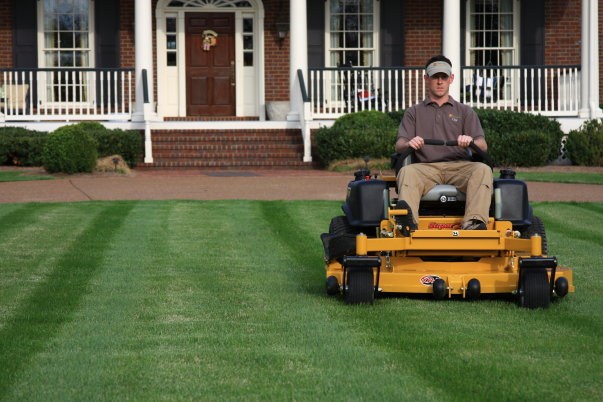Lawn Services of Omaha - Lawn and Landscaping
Aeration - Omaha, Nebraska - Why, How, and When To Aerate Your Lawn
by David Steg on 12/15/15
In order to achieve and maintain a beautiful lawn, you should employ basic lawn care practices such as properly mowing, fertilizing and watering. It is also important to ensure that nutrients can reach the soil beneath your grass. Aeration can be an extremely vital element to a healthy lawn because it allows air and water to penetrate built-up grass or lawn thatch.
Get rid of thatch and make way for a beautiful lawn with this quick guide to aeration. You’ll learn why, how and when to aerate your lawn for the best results.
What is Aeration?
Aeration involves perforating the soil with small holes to allow air, water and nutrients to penetrate the grass roots. This helps the roots grow deeply and produce a stronger, more vigorous lawn.
The main reason for aerating is to alleviate soil compaction. Compacted soils have too many solid particles in a certain volume or space, which prevents proper circulation of air, water and nutrients within the soil. Excess lawn thatch or heavy organic debris buried under the grass surface can also starve the roots from these essential elements.
Should You Be Aerating Your Lawn?
One of the most common questions from homeowners is how to determine if they should be aerating their lawn. Your lawn is probably a good candidate for aeration if it:
- Gets heavy use, such as serving as the neighborhood playground or racetrack. Children and pets running around the yard contribute to soil compaction.
- Was established as part of a newly constructed home. Often, the topsoil of newly constructed lawns is stripped or buried, and the grass established on subsoil has been compacted by construction traffic.
- Dries out easily and has a spongy feel. This might mean your lawn has an excessive thatch problem. Take a shovel and remove a slice of lawn about four inches deep. If the thatch layer is greater than one-half inch, aeration is recommended.
- Was established by sod, and soil layering exists. Soil layering means that soil of finer texture, which comes with imported sod, is layered over the existing coarser soil. This layering disrupts drainage, as water is held in the finer-textured soil. This leads to compacted conditions and poor root development. Aerating breaks up the layering, allowing water to flow through the soil more easily and reach the roots.
When to Aerate Your Lawn
The best time for aeration is during the growing season, when the grass can heal and fill in any open areas after soil plugs are removed. Ideally, aerate the lawn with cool season grass in the early spring or fall and those with warm season grass in the late spring.
Aerating Tools: Plug Aerator vs. Spike Aerator
Two main aerating tools exist — a spike aerator and a plug aerator. With a spike aerator, you simply use the tool to poke holes into the ground with a solid tine, or fork. Plug aerators remove a core or plug of grass and soil from the lawn. For the best results, use an aerating tool or machine that actually removes plugs of soil. Poking holes is less effective and can actually cause additional compaction in the areas around the holes.
Look for an aerating tool or machine that removes soil plugs approximately 2 — 3 inches deep and 0.5 — 0.75 inches in diameter, and about 2 — 3 inches apart. These machines can be rented from lawn and garden stores or home improvement centers. Always follow the directions provided by the store. You may want to consider sharing the rental cost with a neighbor who is interested in aerating the lawn.
How to Aerate Your Yard
If you're convinced that your lawn is in need of aeration, here are some lawn care tips on how to do it:
- Before you get started, make sure the soil is moist enough. There's nothing more frustrating than trying to aerate soil that is bone dry. Aerating the day after a rain shower or watering your lawn the day before is advised.
- Most aeration machines cover only a small percentage of soil surface per pass, so make multiple passes over the most compacted areas. Save resources (and your energy) by leaving unaffected areas alone
- The excavated soil plugs should be allowed to dry and then broken up to give your lawn a uniform, clean appearance. Break them up by running them over with a lawn mower or pounding them with the back of a rake. (Your lawn mower blade may need to be sharpened after breaking up the plugs.)
- An aeration myth is that if you apply a preemergent herbicide on your lawn in the spring, aerating your lawn will destroy the herbicide "barrier." This is not true — research shows that aeration will not affect crabgrass control or weed prevention.
- After aerating, it's important to continue basic lawn care practices such as proper fertilizing, mowing and watering.
Aeration is a beneficial practice toward achieving a beautiful lawn, but most people don't realize it or understand the process. If your lawn is a candidate, make it an integral part of your lawn care regime. Your lawn will thank you for letting it breathe again.
When To Fertilize Your Lawn
by David Steg on 12/14/15The million dollar question for many people is "when to fertilize?" To answer this question, you should consider these four factors: climate, grass type, the fertilizer being used, and how you want your lawn to look. For those of us who want our lawn looking its best, then it's a good idea to fertilize your lawn 4-5 times a year. Conversely, even if you don't want a good looking lawn, you should at least fertilize twice a year for your grass's sake. As discussed in the section on grasses, there are two types of grasses: Warm-Season & Cool-Season. Each grass has its own growing season, therefore, each requires a different schedule for fertilizing. As a rule of thumb, it is best to apply fertilizers when your lawn is actively growing. If you fertilize with nitrogen while your lawn is dormant, you can encourage weed growth, and ultimately waste fertilizer.
Warm-Season Grasses flourish during the warmer summer months, and therefore tend to require fertilizing shortly after green-up in the spring and again in the late summer months. For Warm-Season grasses in the southern areas, it is best to concentrate a larger amount of nitrogen to be applied during the early-late spring applications and a lesser amount in the fall. For more information on what nitrogen is, see: What is fertilizer?
The following tables are general fertilizing guidelines that can be used to help determine what the best program is for you. Before you begin using the tables as a reference, there are a few things to remember prior to choosing a fertilizer for your lawn:
- Many fertilizers on the market today come as combinations, or can be mixed during the same application time with other agents. For example, fertilizers are often mixed with weed controls, pest controls, moss controls, dandelion controls, etc.. If they are not mixed, but you have a disease or pest problem, you can purchase the treatment separately and apply it based on your needs. The table below shows the suggested fertilizer components, mixtures, and the correct time for applying those fertilizers based on common seasonal occurrences, such as weed and pest outbreaks. You will need to decide which best applies to your lawn.
- Avoid applying nitrogen when your lawn is dormant or has not yet greened-up. The growing stimulant provided by the nitrogen could end up encouraging weed growth or the growth of other unwanted grasses in your lawn. Always make sure that the nitrogen works for the grass already growing, and not the other stuff. If you have had a long winter and the grass is not yet established, then don't get worried if your schedule to fertilize gets delayed or modified. Your lawn doesn't care what your calendar says, so make sure you're flexible enough to deal with it.
- Make sure you read the label on the fertilizer you buy to know how long it lasts. As discussed in types of fertilizers, time-released fertilizers can slowly release nutrients from 2-8 months. Make sure you provide enough interval between fertilizing to allow the previous application to finish, thereby avoiding over-fertilization and possibly burning your lawn with the next application.
- Before fertilizing,try to make sure your lawn does not have an excess buildup of thatch that can suspend the fertilizer in the grass leaves and inhibiting it from reaching the soil. Suspended fertilizer can also burn the grass leafs.
- Avoid fertilizing your lawn during periods of drought or when it is excessively dry. Most fertilizers need a good couple of waterings after fertilizing, and if the fertilizer sits without a good soaking, it could burn your lawn. If you plan on fertilizing in August during a drought and cannot water your lawn, just wait or even skip the application until more moderate weather arrives. Remember, fertilizing should help your lawn, not hurt it!
- Every lawn and climate is unique. Ultimately, the perfect schedule for your lawn depends on you. If this isn't something you want to tackle, there are others who do this everyday who will.
Plant A Tree During The Winter Months For A Greener Spring
by David Steg on 12/07/15
Winter is one of the best times to plant a tree. Many excellent varieties are available at your local nursery, with some of the best trees available in the winter. Your new tree will use the winter dormant season to establish new roots. When spring arrives, your tree will be on its way to providing shade for generations to come. While it may seen obvious that planting a tree is a good thing, here are some reasons which may not have not occurred to you. Well-placed trees can save you money on your utility bills. In the summer trees shade your roof and windows and also cool the air around your house as they breathe. In the winter, evergreens can block cold north winds. By using less electricity you help cut down on emissions from power plants that contribute to the “green house effect.” Trees of course clean the air by creating oxygen, and they also keep our cities cooler by reducing the “heat island” effect. This is caused by concrete and asphalt storing and reflecting heat, making urban areas hotter.
Choosing a Tree
Ask your nursery professional to recommend a tree that is native or adapted to this area. Don’t ask for the fastest growing tree such as an Arizona ash, cottonwood, Chinese tallow or poplar. Their fast growth results in weak, brittle wood. They are also prone to freeze and insect damage, leaving you with the expense of tree removal just when you expect to be receiving shade. Excellent deciduous trees for this area include Chinese pistache, cedar elm, Drake elm, pecan, Texas ash, and bald cypress. These trees will lose their leaves in the winter and provide access to the winter sun to warm your home. Two of the best choices in this category are the burr and chinquapin oaks. Recommended evergreen selections include live oak, Afghan pine, deodar cedar, and cherry laurel.
Choosing a site
Survey your site and decide the best location for your tree. Choose the variety based on mature size compared to the space you have available. Most planting mistakes are made by placing a tree that will become very large in the wrong place; under a power line or too close to the house, driveway, or walkway. Don’t place the tree near water, gas, cable TV, telephone or sewer lines. In Austin, phone One Call (they’re listed in the Phone book); they will locate and mark all underground utility lines in the digging area. In other locations, call your utility or service supplier. Now dig a test hole. Be sure your location is not one large limestone boulder with a thin layer of soil over it. If you hit a large rock, move over a bit and try again. When you are sure you can dig an adequate hole, then purchase the tree. When you know the size of the hole you can dig, your original plan for a large balled and burlaped tree may change to a five gallon size. The smaller size is easier to plant, less expensive, and may grow more rapidly than the larger tree.
Planting the Tree
Dig your hole three to five times as wide as the container or root ball. The hole should be no deeper than the container. If you disturb the native soil below the root ball, the tree may settle and sink too low. The sides of the hole should not be smooth. Dig an ugly, ragged hole or even a square hole. Use a pick or shovel to break up the vertical soil surface. This gives the roots a chance to grow into the native soil. Carefully remove the tree from its container and place it in the hole. Large trees may require the aid of several helpers to avoid damaging the roots. If the roots have begun to circle inside the container, straighten them out from the root ball as you refill the hole. Most times a newly planted tree will stand on its own. If necessary, drive a sturdy stake at the edge of the root ball. Use an old nylon stocking to loop a loose figure eight around the tree and the stake. Fill the hole with the removed soil, not peat moss, compost, or bagged soil. It’s best to get the tree immediately accustomed to the soil in which it will be growing. Otherwise the roots tend to stay in the amended soil and never grow into the surrounding native soil. As you fill, compress the soil with your foot several times to prevent air pockets. Use the extra soil to build a dam around the edge of the hole. Water thoroughly and deeply. A liquid root stimulator may be used, but is usually not necessary. Cover the area inside the dam with 3-4 inches of organic mulch. In the absence of rain, a good soaking every two weeks is sufficient during the winter.
Warm Weather During Cold Season - Lawn Care Tips
by David Steg on 12/06/15
A friend remarked to me this past weekend that it’s so warm that her forsythia looks like it’s ready to bud out and her jonquils are coming up. She’s worried that they’ll be damaged if it gets cold. Good concern, but maybe premature.
The real concern is extreme fluctuating temperatures. If your flowering shrubs start to bud out, a drastic dip in temperatures shouldn’t harm the tree itself, but it may stunt and/or kill the buds, resulting in fewer flowers in the spring. If our temperatures continue to be mild, without dropping to the teens after a day in the 60’s, then we should be fine. If we gradually return to normal winter temperatures, or stay warm without too much fluctuation, our landscape shouldn’t suffer much.
On the other hand, if you have fruit trees (or a vegetable garden or berry plants,) early flowering is definitely something to worry about. A hard freeze, or even a frost, could lower your harvest considerably – which is something to worry about for our peach growers!
If you see a hard freeze coming, try to cover your tender and vulnerable plants with burlap or plastic – or at least be sure they’re mulched well. There isn’t much you can do for a large tree.
And what about our grass? What really causes winter damage on dormant Bermuda grass lawns is a cycle of freezing and thawing. As long as we don’t have warm days followed by hard freezes, it should be fine. Also in dormant Bermuda lawns, we may see a lot of weeds moving in, germinating as the soil warms, before the Bermuda is out of dormancy. (Easily taken care of with a pre and post-emergent weed control application like we’re putting down now.)
However, if Bermuda grass starts to green up and then we get a frost or hard freeze, thin areas could be killed. The frost goes into the leaf tissue and interrupts the vascular system. Our lack of rain is going to play a big part in this, because dry cold is much more damaging to the grass than wet cold. In fact, snow is actually the best insulator against extreme cold temperatures. Our blizzard last year was followed by temperatures down to -13 here in Tulsa, and -26 in some parts of Oklahoma. What protected our landscapes from severe winter damage was the nice blanket of snow over everything. Plants sticking up above the snow, like crape myrtles, sustained killing injuries to their tops and had to be pruned down.
Cool season grasses, like fescue and rye, should be okay. They are much more tolerant of the cold weather.
How can you be pro-active? Water your lawn and your flowerbeds now. Water provides much-needed insulation against cold temperatures. With temperatures this warm, watering is a smart move. Don’t wait until we have a forecast in the 20’s. Even if we don’t get a hard freeze at all, watering in the winter will keep your lawn and landscape much healthier than those that are not watered.
Another aspect of a warmer winter is that pest levels usually rise, so you’ll have to be on the lookout this spring and summer, especially if you have a vegetable garden. (There are a lot more/bigger bugs in Florida than in Minnesota.)
Warm Weather During Cold Season - Lawn Care Tips
by David Steg on 12/06/15
A friend remarked to me this past weekend that it’s so warm that her forsythia looks like it’s ready to bud out and her jonquils are coming up. She’s worried that they’ll be damaged if it gets cold. Good concern, but maybe premature.
The real concern is extreme fluctuating temperatures. If your flowering shrubs start to bud out, a drastic dip in temperatures shouldn’t harm the tree itself, but it may stunt and/or kill the buds, resulting in fewer flowers in the spring. If our temperatures continue to be mild, without dropping to the teens after a day in the 60’s, then we should be fine. If we gradually return to normal winter temperatures, or stay warm without too much fluctuation, our landscape shouldn’t suffer much.
On the other hand, if you have fruit trees (or a vegetable garden or berry plants,) early flowering is definitely something to worry about. A hard freeze, or even a frost, could lower your harvest considerably – which is something to worry about for our peach growers!
If you see a hard freeze coming, try to cover your tender and vulnerable plants with burlap or plastic – or at least be sure they’re mulched well. There isn’t much you can do for a large tree.
And what about our grass? What really causes winter damage on dormant Bermuda grass lawns is a cycle of freezing and thawing. As long as we don’t have warm days followed by hard freezes, it should be fine. Also in dormant Bermuda lawns, we may see a lot of weeds moving in, germinating as the soil warms, before the Bermuda is out of dormancy. (Easily taken care of with a pre and post-emergent weed control application like we’re putting down now.)
However, if Bermuda grass starts to green up and then we get a frost or hard freeze, thin areas could be killed. The frost goes into the leaf tissue and interrupts the vascular system. Our lack of rain is going to play a big part in this, because dry cold is much more damaging to the grass than wet cold. In fact, snow is actually the best insulator against extreme cold temperatures. Our blizzard last year was followed by temperatures down to -13 here in Tulsa, and -26 in some parts of Oklahoma. What protected our landscapes from severe winter damage was the nice blanket of snow over everything. Plants sticking up above the snow, like crape myrtles, sustained killing injuries to their tops and had to be pruned down.
Cool season grasses, like fescue and rye, should be okay. They are much more tolerant of the cold weather.
How can you be pro-active? Water your lawn and your flowerbeds now. Water provides much-needed insulation against cold temperatures. With temperatures this warm, watering is a smart move. Don’t wait until we have a forecast in the 20’s. Even if we don’t get a hard freeze at all, watering in the winter will keep your lawn and landscape much healthier than those that are not watered.
Another aspect of a warmer winter is that pest levels usually rise, so you’ll have to be on the lookout this spring and summer, especially if you have a vegetable garden. (There are a lot more/bigger bugs in Florida than in Minnesota.)




